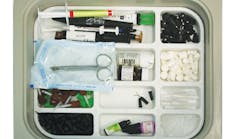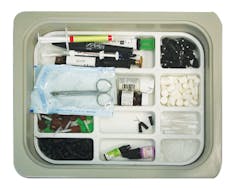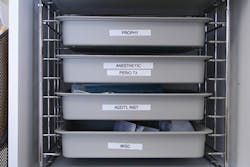Marie T. Fluent, DDS
Catherine L. Pawloski, RDH, BSDH
Patients may perceive a more positive experience on days when the schedule runs smoothly and the office milieu seems calm and relaxed. On such days, productivity may be improved, and the stress level of the dental team reduced.
Likely there are other occasions, though, when the office ambience may feel tense and uncomfortable. Some unavoidable circumstances for such days include patients arriving late for appointments, clinical personnel running behind schedule, or procedures requiring more time than anticipated. However, many such stressful circumstances are preventable.
Productive and smoothly run dental operatories do not happen by chance. The operatory schedule is generally tightly booked with specific times allotted for patient care, operatory breakdown, and preparation for the subsequent patient. In a busy and productive schedule, there is no time allotted for searching for missing instruments, restocking supplies during dental procedures, or retrieving materials from another operatory. Each of these "mishaps" negatively impacts quality time spent with the patient. Thus, treatment room efficiency and chairside organization are paramount to ensure a productive day, a manageable schedule, and a positive patient experience. Following are some clinical tips to enhance safety, chairside organization, and treatment room efficiency to prepare for a predictable, positive, and productive workday.
Prevent infection
While efficiency and timeliness are important in the dental operatory, it is important that clinical personnel do not compromise infection prevention protocol and safety. A well-established and written infection control program promoting standard precautions for each patient must be followed. Even in instances where time is short, clinical personnel must not disregard infection control compliance to save time. For example, contaminated sharps may pose a safety risk to patients and dental personnel if handled improperly, and surface disinfectants may be ineffective at killing microorganisms if not used according to manufacturers' instructions.
Figure 1: Tubs provide the necessary materials for a given procedure, such as crown cementation.
The Centers for Disease Control and Prevention (CDC) document, Guidelines for Infection Control in Dental Health-Care Settings-2003, provides recommendations for infection control policies and protocol. The newest CDC document, Summary of Infection Prevention Practices in Dental Settings: Basic Expectations for Safe Care, offers basic infection prevention measures required for all dental settings and a two-part checklist to assess infection control policies and practices within a dental facility. These documents may be found at cdc.gov/mmwr/preview/mmwrhtml/rr5217a1.htm and cdc.gov/oralhealth/infectioncontrol/pdf/safe-care.pdf. The Organization for Safety, Asepsis and Prevention (OSAP) is an organization dedicated to the infection-free delivery of oral health care. OSAP offers educational resources to improve compliance and practices of infection control recommendations and guidelines. OSAP may be found at osap.org.
Participate in a morning huddle
In making the clinical day efficient and productive, the dental team should be informed of the daily schedule in advance. Clinical personnel may review their operatory schedule the evening before to anticipate which procedures are to be performed and which instruments, materials, and supplies are necessary. Each morning, dental teams typically participate in a morning huddle to review patient schedules. At this time, questions about individual patients or procedures, financial concerns, and adjustments to the schedule may be addressed. Team members may also address the same-day scheduling of anticipated emergencies and unanticipated procedures. As the clinical day progresses, team members should be keenly aware of patient flow in the facility and operatory. Through familiarization of the daily schedule and anticipation of any deviations, efficiency and productivity of the clinical day may be improved.
Prestock and standardize operatories
Prestocking each operatory prior to patient care enhances chairside organization and treatment room efficiency. With identical procedure setups and standardized arrangement of supplies and materials, every clinical team member will be able to easily find instruments and products necessary at any time for any given procedure. An excellent option for storing dental materials is in an enclosed procedure tub (figure 1). These tubs may be color coded according to various procedures or clinician preference. For example, a procedure-specific tub may contain all materials necessary for a routine prophylaxis, such as disposable prophy heads, various types of prophy pastes, fluoride varnish, and cotton rolls. A provider-specific tub for composites may contain either a Tofflemire retainer or sectional matrix system, depending on the clinician's preference. Personal protective equipment (PPE)-such as masks, eye-safety wear for clinicians and patients, and gloves in various sizes-may be easily stored in drawers and wall dispensers. Hand hygiene products are stored at the point of use or near the sink. Disinfectants, barriers, and related products are often stored in a cabinet. Wrapped, sterile instruments and cassettes, and disposables such as HVE tips, saliva ejectors, and gauze are stored in a clean, dry area of the sterilization center or an enclosed area within the treatment room. With prestocking and standardized storage systems in place, searching for missing items during patient care is minimized, procedures are streamlined, and chairside efficiency is enhanced (figure 2).
Figure 2: Standardization of supplies and materials allows dental personnel to easily retrieve supplies and products.
Process instruments and standardize setups through the use of cassettes
The use of cassettes is advantageous over instruments in pouches for many reasons. First, all instruments necessary for a specific procedure are within the cassette, allowing for streamlined instrument setup and breakdown of operatories. Cassettes also allow for safer handling of instruments in all phases of reprocessing, with sharp instruments safely enclosed and instruments handled less. In addition, as new clinical personnel are introduced into an office, cassettes facilitate simple cross-training, as setups are well organized and all instruments are readily available (figure 3). If a dental hygienist or assistant is running behind schedule and another auxiliary enters the operatory, the substitution in personnel should be seamless.
Prepatient preparation
Just as a standardized, prestocked operatory enhances efficiency, a complete operatory setup prior to patient arrival enhances chairside organization and streamlines patient care. In a preset operatory, all instruments, supplies, materials, and disposable items necessary for a given procedure are placed such that they are readily available before the patient is seated. An operatory setup checklist may be fabricated for each type of procedure performed. A checklist serves to ensure that nothing is missed, minimizing time spent away from patient care to retrieve a missing item.
Productivity during downtime
Despite the best efforts of a dental team to keep a full schedule, same-day appointment changes do occur and dental personnel may experience a clinical session with an empty chair. By taking advantage of this time, future chairside efficiency and productivity may be enhanced. Nonclinical hours may be filled with assisting other team members as needed, restocking the operatory, checking inventory of dental supplies and materials, becoming familiar with the schedule for the following day, and documenting clinical notes in the patient chart.
Figure 3: Cassettes facilitate cross-training, as setups are well organized and all instruments are readily available.
Promote and prioritize teamwork
If an assistant or hygienist appears to be falling behind in his or her schedule, another team member may be able to assist with processing instruments, operatory breakdown, or preparation. As team members review the daily schedule, moments of need may be anticipated. In these instances, assistance from another team member may be requested in advance. Some dental facilities have the advantage of a hygiene assistant or a sterilization technician who may help in such circumstances. By working as a team, efficiency may be enhanced and productivity improved during patient care.
Parting comments
Clinical personnel play critical roles in the delivery of safe, high-quality, and timely dental care. Chairside and treatment room processes, procedures, and overall organization contribute significantly to creating smooth, efficient, and stress-free patient flow. Through a strong and consistent commitment to advance preparation, standardization of operatory policies, structured team communication/feedback, and continuous quality improvement, the dental care team is far more likely to experience a predictable, positive, and productive workday with overall improved clinical outcomes and patient satisfaction.
Marie T. Fluent, DDS, is a graduate of the University of Michigan School of Dentistry and has enjoyed 25 years of clinical practice. She is an educational consultant for the Organization for Safety, Asepsis and Prevention (OSAP) and has written peer-reviewed articles and lectures on infection control in the dental setting.
Catherine L. Pawloski, RDH, BSDH, studied at the University of Michigan, receiving her bachelor of science in dental hygiene. She has written articles relating to the topics of infection control in the dental office and Occupational Safety and Health Administration (OSHA)/Centers for Disease Control and Prevention (CDC) guidelines. She currently works in clinical practice in Michigan.









